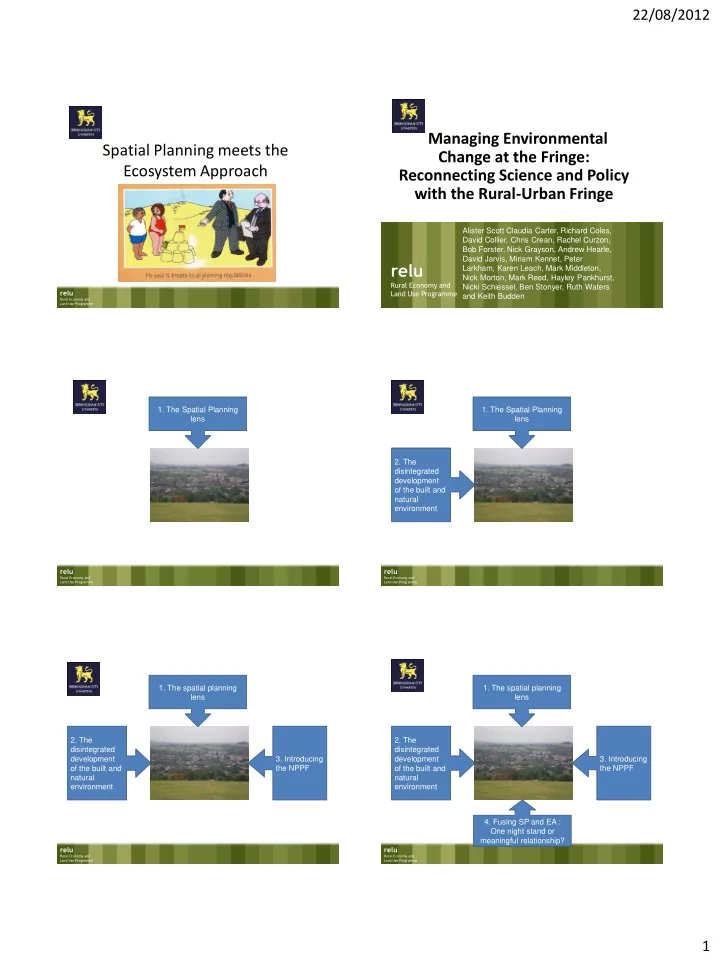

22/08/2012 Managing Environmental Spatial Planning meets the Change at the Fringe: Ecosystem Approach Reconnecting Science and Policy with the Rural-Urban Fringe Alister Scott Claudia Carter, Richard Coles, David Collier, Chris Crean, Rachel Curzon, Bob Forster, Nick Grayson, Andrew Hearle, David Jarvis, Miriam Kennet, Peter relu Larkham, Karen Leach, Mark Middleton, Nick Morton, Mark Reed, Hayley Pankhurst, Rural Economy and Nicki Schiessel, Ben Stonyer, Ruth Waters relu relu Land Use Programme and Keith Budden Rural Economy and Rural Economy and Land Use Programme Land Use Programme 1. The Spatial Planning 1. The Spatial Planning lens lens 2. The disintegrated development of the built and natural environment relu relu Rural Economy and Rural Economy and Land Use Programme Land Use Programme 1. The spatial planning 1. The spatial planning lens lens 2. The 2. The disintegrated disintegrated development 3. Introducing development 3. Introducing of the built and the NPPF of the built and the NPPF natural natural environment environment 4. Fusing SP and EA : One night stand or meaningful relationship? relu relu Rural Economy and Rural Economy and Land Use Programme Land Use Programme 1
22/08/2012 Connecting People-Place-Environment Spatial Planning • Dan’s cartoon please EA relu relu Rural Economy and Rural Economy and EUROCITIES (2004) The Pegasus files: a practical guide to integrated area-based urban planning EUROCITIES , Land Use Programme Land Use Programme Brussels Academic Ingredients Policy Ingredients 1. Culture change (Nadin, 2007) • “Applied common sense” David Collier. 2. Positivity and Proactivity (Mommaas and Jansen, 2008) 3. Place making (Davoudi and Pendlebury 2010). 4. Evidence-based (UCL and Deloitte 2007) 5. Multiple (Fluid) Scales (Allmendinger and Haughton 2006) 6. Multiple Sectors (Jordan and Halpin 2006: Morphet, 2010) 7. Partnerships (Scott M 2003: Allmendinger 2009)) 8. Long Termism/Visions (Low, 2002) 9. Connectivity (Albrechts, 2004: Hodge and Monk 2004) 10. Values (Healey, 2008: Inch 2010) 11. Inclusion (Healey 2008) 12. Social learning (Bull et al 2008 ) relu relu Building interdisciplinarity across the Rural Economy and Rural Economy and rural domain Land Use Programme Land Use Programme Disintegrated Development Mind the gap • Natural Environment lens • Built Environment lens 1. Natural Environment White Paper 1. National Planning Policy Framework 2. Habitat and Landscape 2. Local 3. DEFRA 3. DCLG 4. Ecosystem Approach 4. Spatial Planning 5. Classifying and Valuing 5. Zoning and Ordering 6. National Ecosystem Assessment 6. Sustainability Assessments 7. Integrated Biodiversity 7. Development/Neighbourhood Plans Development Areas 8. Enterprise Zones / Green Belts 8. Nature Improvement Areas 9. Local Enterprise Partnerships 9. Local Nature Partnerships relu relu Rural Economy and Rural Economy and Land Use Programme Land Use Programme 2
22/08/2012 Disintegrated Development • Built Environment lens • Natural Environment lens Natural Environment lens Built Environment lens 1. Incentives 1. Incentives 1. Control 1. Control 2. Natural Environment White Paper 2. Natural Environment White Paper 2. National Planning Policy Framework 2. National Planning Policy Framework 3. Habitat and Landscape 3. Habitat and Landscape 3. Local 3. Local 4. DEFRA 4. DEFRA 4. DCLG 4. DCLG 5. Ecosystem Approach 5. Ecosystem Approach 5. Spatial Planning 5. Spatial Planning 6. Classifying and Valuing 6. Classifying and Valuing 6. Zoning and Ordering 6. Zoning and Ordering 7. National Ecosystem Assessment 7. National Ecosystem Assessment 7. Sustainability Assessments 7. Sustainability Assessments 8. Integrated Biodiversity 8. Integrated Biodiversity 8. Development/Neighbourhood Plans 8. Development/Neighbourhood Plans Development Areas Development Areas 9. Enterprise Zones / Green Belts 9. Nature Improvement Areas 9. Nature Improvement Areas 9. Enterprise Zones / Green Belts 10. Local Enterprise Partnerships 10. Local Nature Partnerships 10. Local Nature Partnerships 10. Local Enterprise Partnerships relu relu Rural Economy and Rural Economy and Land Use Programme Land Use Programme Natural Environment lens Built Environment lens Natural Environment lens Built Environment lens 1. Incentives 1. Control 1. Incentives 1. Control 2. Natural Environment White Paper 2. Natural Environment White Paper 2. National Planning Policy Framework 2. National Planning Policy Framework 3. Habitat and Landscape 3. Habitat and Landscape 3. Local and Neighborhood 3. Local and Neighborhood 4. DEFRA 4. DEFRA 4. DCLG 4. DCLG 5. Ecosystem Approach 5. Ecosystem Approach 5. Spatial Planning 5. Spatial Planning 6. Classifying and Valuing 6. Classifying and Valuing 6. Zoning and Ordering 6. Zoning and Ordering 7. National Ecosystem Assessment 7. National Ecosystem Assessment 7. Sustainability Assessments 7. Sustainability Assessments 8. Integrated Biodiversity 8. Integrated Biodiversity 8. Development/Neighbourhood Plans 8. Development/Neighbourhood Plans Development Areas Development Areas 9. Nature Improvement Areas 9. Enterprise Zones / Green Belts 9. Nature Improvement Areas 9. Enterprise Zones / Green Belts 10. Local Nature Partnerships 10. Local Nature Partnerships 10. Local Enterprise Partnerships 10. Local Enterprise Partnerships relu relu Rural Economy and Rural Economy and Land Use Programme Land Use Programme Natural Environment lens Built Environment lens Natural Environment lens Built Environment lens 1. Incentives 1. Control 1. Incentives 1. Control 2. Natural Environment White Paper 2. National Planning Policy Framework 2. Natural Environment White Paper 2. National Planning Policy Framework 3. Habitat and Landscape 3. Habitat and Landscape 3. Local and Neighbourhood 3. Local and Neighbourhood 4. DEFRA 4. DEFRA 4. DCLG 4. DCLG 5. Ecosystem Approach 5. Ecosystem Approach 5. Spatial Planning 5. Spatial Planning 6. Classifying and Valuing 6. Classifying and Valuing 6. Zoning and Ordering 6. Zoning and Ordering 7. National Ecosystem Assessment 7. National Ecosystem Assessment 7. Sustainability Assessments 7. Sustainability Assessments 8. Integrated Biodiversity 8. Integrated Biodiversity Development Areas 8. Development/Neighbourhood Plans Development Areas 8. Development/Neighbourhood Plans 9. Nature Improvement Areas 9. Enterprise Zones / Green Belts 9. Nature Improvement Areas 9. Enterprise Zones / Green Belts 10. Local Nature Partnerships 10. Local Nature Partnerships 10. Local Enterprise Partnerships 10. Local Enterprise Partnerships relu relu Rural Economy and Rural Economy and Land Use Programme Land Use Programme 3
Recommend
More recommend